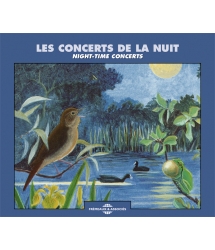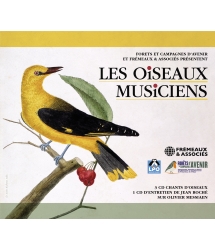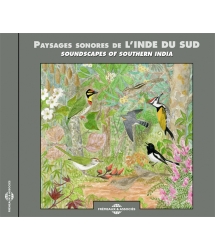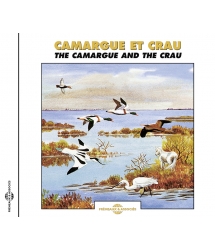- Our Catalog
- Philosophy
- Philosophers of the 20th century and today
- History of Philosophy (PUF)
- Counter-History and Brief Encyclopedia by Michel Onfray
- The philosophical work explained by Luc Ferry
- Ancient thought
- Thinkers of yesterday as seen by the philosophers of today
- Historical philosophical texts interpreted by great actors
- History
- Books (in French)
- Social science
- Historical words
- Audiobooks & Literature
- Our Catalog
- Jazz
- Blues
- Rock - Country - Cajun
- French song
- World music
- Africa
- France
- Québec / Canada
- Hawaï
- West Indies
- Caribbean
- Cuba & Afro-cubain
- Mexico
- South America
- Tango
- Brazil
- Tzigane / Gypsy
- Fado / Portugal
- Flamenco / Spain
- Yiddish / Israel
- China
- Tibet / Nepal
- Asia
- Indian Ocean / Madagascar
- Japan
- Indonesia
- Oceania
- India
- Bangladesh
- USSR / Communist songs
- World music / Miscellaneous
- Classical music
- Composers - Movie Soundtracks
- Sounds of nature
- Our Catalog
- Youth
- Philosophy
- News
- How to order ?
- Receive the catalog
- Manifesto
- Dictionnary











- Our Catalog
- Philosophy
- Philosophers of the 20th century and today
- History of Philosophy (PUF)
- Counter-History and Brief Encyclopedia by Michel Onfray
- The philosophical work explained by Luc Ferry
- Ancient thought
- Thinkers of yesterday as seen by the philosophers of today
- Historical philosophical texts interpreted by great actors
- History
- Books (in French)
- Social science
- Historical words
- Audiobooks & Literature
- Our Catalog
- Jazz
- Blues
- Rock - Country - Cajun
- French song
- World music
- Africa
- France
- Québec / Canada
- Hawaï
- West Indies
- Caribbean
- Cuba & Afro-cubain
- Mexico
- South America
- Tango
- Brazil
- Tzigane / Gypsy
- Fado / Portugal
- Flamenco / Spain
- Yiddish / Israel
- China
- Tibet / Nepal
- Asia
- Indian Ocean / Madagascar
- Japan
- Indonesia
- Oceania
- India
- Bangladesh
- USSR / Communist songs
- World music / Miscellaneous
- Classical music
- Composers - Movie Soundtracks
- Sounds of nature
- Our Catalog
- Youth
- Philosophy
- News
- How to order ?
- Receive the catalog
- Manifesto
- Dictionnary
FORESTS OF POLAND - BIALOWIEJA
JEAN CLAUDE ROCHE
Ref.: FA684
Artistic Direction : JEAN ROCHE
Label : Frémeaux & Associés
Total duration of the pack : 1 hours 13 minutes
Nbre. CD : 1
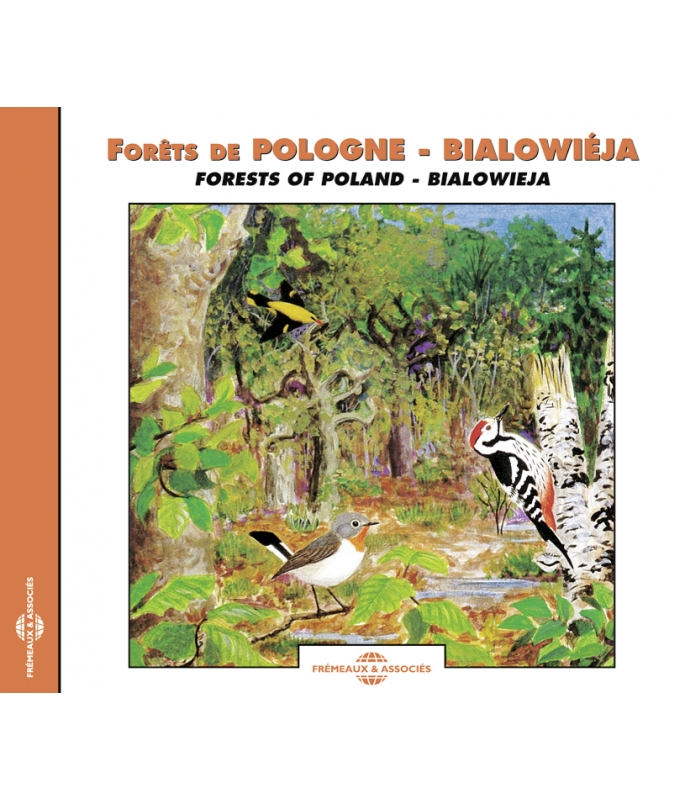
FORESTS OF POLAND - BIALOWIEJA
FORESTS OF POLAND - BIALOWIEJA
This Compact Disc provides the listener with 13 concerts, in true live stereo, recorded during May in the famous Bialowieja National Park, in the far east of Poland. The absence of the normal noise associated with our mechanical world, and the cathedral effect on the bird songs, unknown in western Europe, such as of the Thrush Nightingales, the Barred Warbler and Collared and Red-breasted Flycatcher, all kept in rhythm by the drumming of woodpeckers, of witch there are no less than eight species in this forest. Recording made by Thierry Gaultier and Jean-Claude Roché and described in a 8 pages French and English booklet. Patrick FRÉMEAUX
13 Natural Soundscapes recorded in a mixed mature forest with undergrowth, grounds around the village, and in the protected primeval forest.
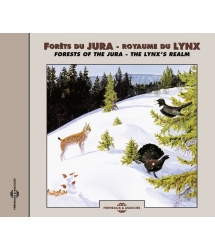
FORESTS OF THE JURA - THE LYNX'S REALM
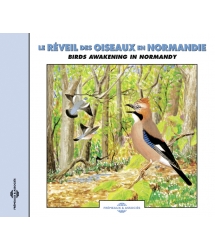
BIRDS AWAKENING IN NORMANDIE
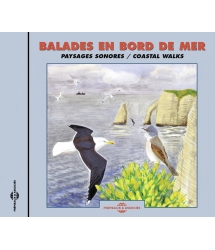
WALKS ON THE FORESHORE - COASTAL WALKS



-
PisteTitleMain artistAutorDurationRegistered in
-
1Chœur de l'aube avec Chouette Hulotte, Merle noir, Rossignol progné…Dawn chorus with Towny Owl, Blackbird, Thrush Nightingale, Robin…00:09:481993
-
2Dialogue d'un Gobemouche noir et d'un PinsonDialogue of a Pied Flycatcher and a Chaffinch00:04:441993
-
3Chant d'un Gobemouche noir accompagné par coucou, pinson et geai…Song of a Collared Flycatcher, accompanied by Cuckoo, Chaffinch and Jay…00:02:111993
-
4Un autre Gobemouche noir avec Grive musicienne, Grand Corbeau…Another Pied Flycatcher, with Song Thrush, Raven and Great Spotted Woodpecker…00:05:081993
-
5Chœur du matin avec Pouillot véloce, Rougegorge, Grand Corbeau…A morning chorus with Chiffchaff, Robin, Raven, Song Thrush…00:11:131993
-
6Chœur du matin avec Pouiillot siffleur, Grand Corbeau, Grive musicienne…A morning chorus with Wood Warbler, Raven, Song Thrush…00:04:411993
-
7Chant d'un Loriot au premier plan avec Fauvette des jardins, Grand Corbeau…Golden Oriole singing in the foreground, with Garden Warbler, Raven, Starling…00:02:201993
-
8Chœur de l'aube avec chouette hulotte, Merle noir, Pouillot siffleur…Dawn chorus with Tawny Owl, Blackbird, Wood Warbler and Cuckoo…00:04:561993
-
9Rosssignol progné avec au loin Coqs domestiques, Pinson et LoriotThrush Nightingale, and in the distance, cockerels, chaffinch and Golden Oriole…00:03:181993
-
10Fauvette épervière au début, puis Pic épeiche, Pinson, cris d'une biche au loin…Barred Warblers at the start, then Great Spotted Woodpecker, Chaffinch, cry of a red Deer…00:08:091993
-
11Fauvette épervière avec chiens au loin, Coucou, Loriot, Rossignol progné…Barred Warblers with dogs in the distance, Cuckoo, Golden Oriole, Thrush Nightingale…00:09:111993
-
12Deux mâles de Gobemouche nain se répondant, Pouillot siffleur, Merle noir…Two males Red-breasted Flycatcher call to each other, Wood Warbler, Blackbird…00:03:001993
-
13Tambourinages d'un Pic épeiche avec Gobemouche à collier, Pic noir, Pouillot siffleur…Drumming of Great Spotted Woodpecker with collared Flycatcher, Black Woodpecker…00:04:421993
Forêts de POLOGNE - BIALOWIÉJA Forests of poland - bialowieja
Forêts de POLOGNE - BIALOWIÉJAForests of poland - bialowieja
Introduction
Lorsqu’on arrive par la petite route en cul-de-sac au village de Bialowiéja, après une traversée plutôt triste de la Pologne industrielle, c’est l’enchantement ! Pas d’usines, pas d’avions, un vrai silence. Un village charmant, avec un grand parc clos et plein d’oiseaux, où se trouvent les deux hôtels et la Direction du Parc National de Bialowiéja. Autour du village, des prairies et quelques cultures, puis c’est la forêt. Forêt primaire d’un côté, qu’il faut atteindre à pied, pleine de pics – pas moins de 8 espèces vivent là ; forêt exploitée mais protégée de l’autre côté, avec ses sous-bois frais, ses futaies mixtes très hautes, et ses clairières. On sait que Bisons, Loups et Lynx vivent dans ce parc, mais nous ne verrons durant notre bref séjour, du 14 au 18 mai 1992 que les Bisons, silencieux à cette époque. La densité des oiseaux est extraordinaire et les chœurs de l’aube, qui commencent avant 4 heures du matin, ont une sonorité particulière. La multiplicité des grands troncs crée des échos à l’infini et produit un effet “cathédrale” que je n’avais jamais entendu ailleurs, si ce n’est au Canada. Les espèces sont assez semblables, pour l’essentiel, à celles de nos forêts de l’Ouest européen, mais nous trouvons ici en lisière la Fauvette épervière et le Rossignol progné, tandis qu’en futaie l’on entend partout les mélodies mélancoliques du Gobemouche à collier et du Gobemouche nain. Mélodies et sonorités nouvelles pour celui qui vient de l’Ouest ! Nous avons enregistré ces 13 concerts en stéréophonie vraie entre 4 et 6 heures du matin et les huit premiers vous sont restitués sans aucun travail de studio, tel qu’ils ont été captés. Ceux réalisés près du village ont dû être travaillés et il a fallu enlever des bruits humains. Nous n’avons pas voulu gâcher l’authenticité de nos prises de son, comme d’autres l’ont fait, en y mixant artificiellement des chants de loups enregistrés à une autre saison dans un zoo français ! A chacun sa philosophie !
Jean-Claude Roché © 1993 SITTELLE - 2010 FRÉMEAUX & ASSOCIÉS
A. FUTAIE MIXTE AVEC SOUS-BOIS
1. Chœur de l’aube avec Chouette hulotte, Merle noir, Rossignol progné, Rougegorge, Pouillot siffleur et Coucou gris. (9’50)
2. Dialogue d’un Gobemouche noir et d’un Pinson. Au second plan, Loriot, Pouillot siffleur et Pic noir. (4’44)
3. Chant d’un Gobemouche à collier, accompagné par Coucou, Pinson et Geai. (2’12)
4. Un autre Gobemouche noir avec Grive musicienne, Grand Corbeau et Pic épeiche. (5’09)
5. Chœur du matin avec Pouillot véloce, Rougegorge, Grand Corbeau, Grive musicienne, Pic épeiche et Coucou. (11’14)
6. Chœur du matin avec Pouillot siffleur, Grand Corbeau, Grive musicienne, Mésange charbonnière et Pic épeiche. (4’41)
7. Chant d’un Loriot au premier plan avec Fauvette des jardins, Grand Corbeau, Etourneau sansonnet, Pouillot fitis, Tourterelle des bois et Coucou. (2’21)
8. Chœur de l’aube avec Chouette hulotte, Merle noir, Pouillot siffleur et Coucou. (4’56)
B. LE PARC DU VILLAGE
9. Rossignol progné avec au loin Coqs domestiques, Pinson et Loriot. (3’19)
10. Fauvette épervière au début, puis Pic épeiche, Pinson, cris d’une biche au loin, Loriot, Coucou, Pigeons ramier, Gobemouche noir, Pic noir et Pouillot véloce. (8’11)
11. Fauvette épervière avec chiens au loin, Coucou, Loriot, Rossignol progné, Pigeon colombin, Pigeon ramier, Grive musicienne, Fauvette des jardins, Bruant jaune et Fauvette à tête noire. (9’13)
C. LA FORET PRIMAIRE PROTÉGÉE
12. Deux mâles de Gobemouche nain se répondant, Pouillot siffleur, Merle noir, Pinson et Coucou. (3’01)
13. Tambourinages d’un Pic épeiche avec Gobemouche à collier, Pic noir, Pouillot siffleur, Pinson, Fauvette des jardins, Pigeon ramier, Grand Corbeau et Coucou. (4’44)
Les enregistrements 1-8 et 10-11 sont de Jean C. Roché, tandis que les 9, 12 et 13 sont de Thierry Gaultier.
NOTES ORNITHOLOGIQUES :
La plupart des espèces présentes dans ces 13 concerts sont communes dans nos forêts de l’Ouest européen, sauf les 4 espèces suivantes : Rossignol progné, Fauvette épervière, Gobemouche nain et Gobemouche à collier.
Le ROSSIGNOL PROGNÉ Luscinia luscinia est proche de notre Rossignol philomèle et le remplace en Europe de l’Est, depuis le Sud de la Finlande et la Pologne, jusqu’en Bulgarie, et dans l’ex-URSS. Aime les haies épaisses et les sous-bois. Son chant est plus lent, plus puissant, plus contrasté avec des grincements et des sons rauques suivis de notes éclatantes et pures.
La FAUVETTE ÉPERVIÈRE Sylvia nisoria a exactement la même répartition et le même habitat que le Rossignol progné. Elle est gris clair, chinée en dessous. Son chant ressemble beaucoup à celui de notre Fauvette des jardins, mais les notes sont un peu plus hautes, mieux détachées, et le timbre est plus clair.
Le GOBEMOUCHE NAIN Ficedula parva, rappelle un peu le Rougegorge avec son plastron orange, mais sa silhouette et son comportement l’en distinguent aisément. C’est un oiseau des futaies fraîches où il se tient dans les strates inférieures assez près du sol. On le trouve en Europe centrale depuis la Yougoslavie jusqu’à la Pologne, et aussi dans le Sud de la Scandinavie. Son chant mélancolique, fait de petites phrases sifflées sur un rythme calme ressemble à celui du Gobemouche noir, mais les finales, le plus souvent descendantes, sont caractéristiques.
Le GOBEMOUCHE A COLLIER Ficedula albicollis est aussi un oiseau des forêts fraîches, mais il chante en haut des arbres. Sa distribution est moins nordique que celle du Gobemouche nain. Elle reste continentale, mais descend jusqu’à la Grèce. On trouve quelques individus dans nos forêts en Lorraine. Le chant est très différent de celui du Gobemouche noir : il est aigu, acide, syncopé, un peu difficile à saisir au milieu du concert matinal.
Pour les autres espèces de ce CD, se reporter à notre guide sonore : “Tous les oiseaux d’Europe” en 4 CD (ref. FA625) Qui vous donnera leurs cris, leurs chants, avec des commentaires (dans un livret d‘accompagnement de 52 pages).
Jean-Claude Roché ©
1993 SITTELLE - 2010 FRÉMEAUX & ASSOCIÉS
English notes
Introduction
After crossing the sad scenery of industrial Poland, Bialowieja village, reached along a narrow dead-end road, is enchanting. No factories, no aeroplanes, real silence. A charming village, within a closed park full of birds, with two hotels of the Balowieja National Park Board. Around the village, meadows and a few fields of crops, beyond that it’s forest. On one side primeval forest, only reached on foot, with its immense upright tree trunks, others fallen to the ground, full of woodpeckers (no less than 8 species occur here); on the other side, a worked but protected forest, mature managed mixed woodland of tall trees, with shaded undergrowth and clearings. We know that Bison, Wolves and Lynx all live in the Park, but of these we only saw Bison during our short stay from 14th to 18th May 1992. They are quiet at this season. There is an extraordinary density of birds and the dawn chorus, which starts before 4 a.m. has a special quality. The multitude of large tree trunks creates an infinite quantity of echoes, producing a “cathedral” effect, the likes I have heard nowhere else, except maybe in Canada. The list of the species is, for the most part, similar to that of west European forests, but the forest edge is home to the Barred Warbler and the Thrush Nightingale, whereas the melancholy melodies of the Collared and Redbreasted Flycatchers are to be heard everywhere in the mature forest. These are new melodies and sounds to those of us from western Europe. We recorded the 13 concerts in real stereo between 4 and 6 a.m., and the first eight are produced as recorded without any work in studio. Those recorded near the village needed some work doing, in order to eliminate man-made noises. We didn’t wish to spoil the authenticity of our recordings, as others have done, by artificially mixing in the cries of wolves taken at another season in a zoo in France! To each, his own philosophy!
Jean-Claude Roché
Translated in English by Tony Williams
© 1993 SITTELLE - 2010 FRÉMEAUX & ASSOCIÉS
A. MIXED MATURE FOREST WITH UNDERGROWTH
1. Dawn chorus with Towny Owl, Blackbird, Thrush Nightingale, Robin, Wood Warbler and Cuckoo (9’50)
2. Dialogue of a Pied Flycatcher and a Chaffinch. In the background Golden Oriole, Wood Warbler and Black Woodpecker. (4’44)
3. Song of a Collared Flycatcher, accompanied by Cuckoo, Chaffinch and Jay. (2’12)
4. Another Pied Flycatcher, with Song Thrush, Raven and Great Spotted Woodpecker. 5’09
5. A morning chorus with Chiffchaff, Robin, Raven, Song Thrush, Great Spotted Woodpecker and Cuckoo. (11’14)
6. A morning chorus with Wood Warbler, Raven, Song Thrush, Great Tit and Great Spotted Woodpecker. (4’11)
7. Golden Oriole singing in the foreground, with Garden Warbler, Raven, Starling, Willow Warbler, Turtle Dove and Cuckoo. (2’21)
8. Dawn Chorus with Tawny Owl, Blackbird, Wood Warbler and Cuckoo. (4’56)
B. GROUNDS AROUND THE VILLAGE
9. Thrush Nightingale, and in the distance, cockerels, Chaffinch and Golden Oriole. (3’39)
10. Barred Warbler at the start, then Great Spotted Woodpecker, Chaffinch, cry of a Red Deer in the distance, Golden Oriole, Cuckoo, Woodpigeon, Pied Flycatcher, Black Woodpecker and Chiffchaff. (8’11)
11. Barred Warblers with dogs in the distance, Cuckoo, Golden Oriole, Thrush Nightingale, Stock Dove, Woodpigeon, Song Thrush, Garden Warbler, Yellow Hammer and Blackcap. (9’13)
C. THE PROTECTED PRIMEVAL FOREST
12. Two males Red-breasted Flycatcher calling to each other, Wood Warbler, Blackbird, Chaffinch and Cuckoo. (3’01)
13. Drumming of Great Spotted Woodpecker with Collared Flycatcher, Black Woodpecker, Wood Warbler, Chaffinch, Garden Warbler, Woodpigeon, Raven and Cuckoo. (4’44)
Tracks 1-8, 10 and 11 were recorded by Jean C. Roché, whereas 9, 12 and 13 are by Thierry Gaultier.
ORNITHOLOGICAL NOTES
All the species recorded in these 13 concerts are common in the forest of western Europe, except for the following 4: Thrush Nightingale, Barred Warbler, Red-breasted and Collared Flycatchers.
The THRUSH NIGHTINGALE Luscinia luscinia is similar to our Nightingale and replaces it in eastern Europe, from southern Finland and Poland as far as Bulgaria and the ex-USSR. It likes thick hedges and forest undergrowth. Its song is slower, louder, more variable with grating and harsh sounds followed by ringing, pure notes.
The BARRED WARBLER Sylvia nisoria has exactly the same distribution and uses the same habitat as the Thrush Nightingale. It is pale grey, barred beneath. Its song very much resembles that of our Garden Warbler; however its notes are a little higher pitched, better separated and the tone is clearer.
The RED-BREASTED FLYCATCHER Ficedula parva, recalls the Robin with its orange breast, but its silhouette and behaviour at once distinguish it. It’s a bird of cool mature forests where it occupies the lower layers quite near the ground. In central Europe it occurs from Yougoslavia to Poland, as well as in southern Scandinavia. Its melancholic song, of short whistled phrases and calm rhythm is similar to that of the Pied Flycatcher, but the last notes, often descending, are characteristic.
The COLLARED FLYCATCHER Ficedula albicollis is another bird of cool forests, but which sings from the treetops. It has a less northerly distribution than the Red-breasted Flycatcher, occurring on the European mainland as far as Greece. A few occur to that of the Pied Flycatcher: it is his high-pitched, sharp, faint, and a little difficult to distinguish in the middle of a morning concert.
For the other species of this Compact Disc, refer to our Sound Guide : “All the Bird Songs of Britain and Europe” on 4 CDs (ref. FA625) Which has recordings of their calls, with commentaries (in a 52 pages booklet with both French and English Liner Notes)
Jean-Claude Roché - Translated in English by Tony Williams
© 1993 SITTELLE - 2010 FRÉMEAUX & ASSOCIÉS
CD Forêts de Pologne - Bialowiéja © Frémeaux & Associés / roits audio : Frémeaux & Associés - La Librairie Sonore (Producteur initial : Sittelle, Pithys, Collection Allain Bougrain Dubourg ou Ceba) / Ecouter les chants d'oiseaux sur CD : Sons et ambiances naturelles des écosystèmes - Stéreo and digital recording of the natural landscape sound. Natural sound sceneries of écosystems, Voices of the Wild Life. Les droits de cet enregistrement sont protégés par la loi. Pour toute exploitation d’illustration sonore sur CD, DVD, CD-Rom, Télévision, Cinéma, Sites internet, scénographies (théâtre, musées…), l’autorisation et un devis gratuit peuvent être obtenus auprès de Frémeaux & Associés – fax : +33 (0)1 43.65.24.22 info@fremeaux.com
